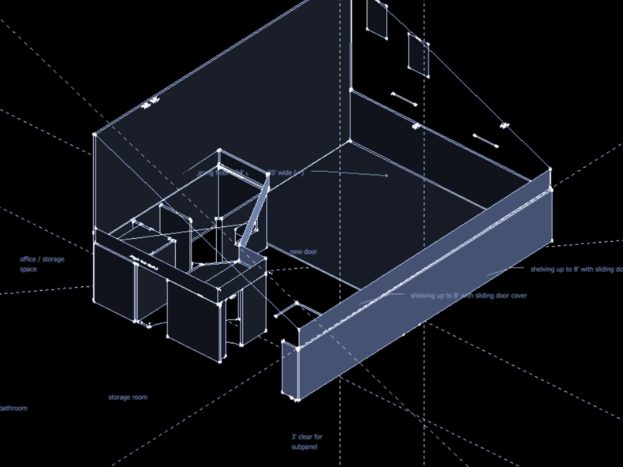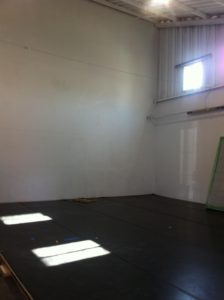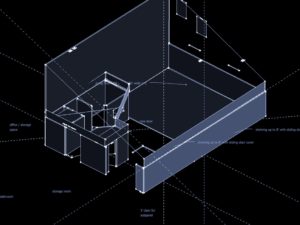
The Milkbar, a home for experimental dance, music, theater, film, site-specific, installation, and cross- and inter-disciplinary works of all kinds, has moved. We’re thrilled about our new space and want to invite you into the process of making it what it will become. The Milkbar used to reside in a small, funky but beautiful warehouse space within the sprawling Sunshine Biscuit Factory in East Oakland and is now in a large soaring warehouse space included in the Bridge Storage and Art Center in Richmond. Through eviction and market forces and the necklace of connections that is the Bay Area art world, we find ourselves moved from one urban industrial neighborhood in the East Bay to another very similar one, just at the opposite end of the East Bay. At this juncture of change, disruption, and new beginnings— and a growing clarity about what is staying the same—we the artists who call the Milkbar home: Mary Armentrout dance/performance; Ian Winters, video/installation; and Merlin Coleman, music/performance, are reaching forward to embrace a new vision of what the Milkbar can be.
So, yes, at the Biscuit Factory we were unceremoniously evicted by our corporate landlords, Uhaul, for no identifiable cause after 12 years, and with no reasonable recourse, but that is just a hard truth of trying to survive as artists with space in this Bay Area economy of boom and bubble. We are fortunate to land on our feet within the supportive community of the Bridge Art Center, where the landlords actively want to support a performance space, and where there is an already thriving community of artists and nonprofits that we are now part of.

That in itself is a big change, but even bigger are the changes in the size and shape and location of the actual space of the Milkbar. We now have a much bigger space – one giant room that is 35 feet by 50 feet with soaring ceilings to 26 feet at the tall end. We have been busy this last year, with a helpful army of volunteers and benefactors big and small, building out this gorgeous raw space into a fluid multi-use space for performance and installation. To accommodate dance, we’ve installed a large 24 feet by 32 feet sprung floor occupying half the space with great sight lines up the tall high wall, thinking of the light and projection possibilities this offers. And we have also built a loft and some storage areas, keeping the sightlines and theatrical possibilities open, so that the whole space can be used for performance, and can be set up using the stage space either long-ways or wide-ways.
Additionally, as part of the building out of the space we have created a shop area to facilitate electronics, set and other construction – with nearly unlimited electrical power for lighting, construction and other work. And then, in regards to access and visibility, unlike at the Biscuit Factory where we were hidden away upstairs, we find ourselves now in Richmond on the ground floor, right on the street, with a front door, a roll up door, and an ADA accessible downstairs. We are much more open and available to the world, which feels new and different, and we are looking to build on that positive change.
One last spatial attribute that is peculiar and oh-so-special about this new situation is the rest of the grounds of the Bridge Art and Storage Center and our access to them. Our new landlords recognize that we are known for sprawling site-specific performance installations and are game to support that aspect of our work as well, so the meandering, disparate spaces of the whole center are available for us to work into, including a vast parking lot for large vehicles underneath the 580 freeway, a kooky storage tower of tight hallways and numberless doors, and the outside walkways between the other artist studios and storage units—urban concrete mazes of steel container rows with repeating orange doors. These additional urban spaces and the ability to incorporate them into future projects is delicious and exciting.

As the Milkbar evolves in this new and different spatial container within the Bridge community, we are also listening to the impulses we have for further evolutions. The primary impulse is to find ways to be more of a positive presence in the actual neighborhood that we are in. It has been interesting to move from one industrial neighborhood to another and reflect on what is different and what has stayed the same. If anything, we feel the gentrifying force of our presence more than before, although it probably remains pretty much the same. At the Biscuit Factory we pondered how to be more connected and present in our East Oakland neighborhood for many years without making much progress, and were just finally taking some steps in that direction, but then the move intervened. Now, as we consider how to move forward with this important idea, we are thinking about how to unspool the conundrum of the experimental artists pushing into the working class neighborhoods, which is where we can afford to be, but where, we notice ourselves making the assumption, there doesn’t seem to be a lot of interest in experimental work. How do these things go together in a mutually beneficial way? How do we keep working in experimental ways and engage and dialogue with the neighbors who live around the block from us, in ways that are compelling to both them and us? And adding in an awareness of the race and class mechanisms functioning in this dynamic as well – we are, at the moment, three white artists, working in experimental ways, in a highly diverse neighborhood (a quarter each white, African American, Latino, and Asian). Experimental art, through the de facto segregation of our society, remains at this time not particularly diverse, although hopefully moving in a more inclusive direction; how can we support and collaborate in a more inclusive and diverse embodiment of experimental, site-specific installation performance art and include our neighbors in the joy, power, complexity, difficulty, and excitement of this project? In other words how do we move from being an unaware part of the gentrifying and displacing wave, to becoming a positive, responsive part of the community? As we mull over the different projects and programs we want to build into this different Milkbar, these are the questions we are pondering. Some of the programs we are considering are:
- Invite other long term artist partners
- Create a revamped artist-in-residency program, perhaps with a community component
- Continue our Salon series and add a presenting series/renting the space for shows
- Build a more robust workshop and class schedule, starting from our annual Summer Intensives
- Build a research program into artist devised tools and compositional practice at the intersection of performance, installation and technology
- Create a series of community dinners under the freeway, a Milkbar cross-disciplinary think tank, community Feldenkrais classes/clinic, a tinkerers’ workshop, an ongoing co-working studio day for people working with media, sound and performance where the studio is open all day for shared work and creation with a mealtime discussion
- Partner with other spaces and organizations, both locally in Richmond and more broadly throughout the East Bay, as we did before with TAC and Subterranean Arthouse


